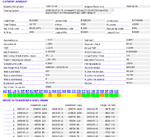I'll reply as I read, in order not to forget anything.
By what I am reading you're not asking for my code, but you are nonetheless asking to know exactly how my systems work (so you can back-test them), and to me that represents exactly the same problem. I don't mean to be rude or offend you. I am giving you the same answer I gave to other people before.
You're right about that idea that I should not stop trading the systems that don't work or increase the capital allocated to those that work best,
if I did that with a
short forward-testing period. But it makes sense to do so if they don't work for a period of 7 months of forward testing (dozens of trades per system). After all, that's the principle by which we discard systems that don't work in back-testing. We don't keep them and say "they didn't work but they might start working", just as we don't discard those that worked expecting them to stop working. We assume that what worked will continue to work and viceversa (given a reasonable test period).
Here's the equity line of all my systems put together, with 1 contract traded per system, regardless of how good that system is. You'd need about 20k to trade all systems together, but then again you could incur its worst drawdown (cfr. fall from 31k to 17k) and lose all 20k immediately, so it's best to start with 40k.

To trade the systems with 1 contract per system, you'd need the capital needed to trade them all (20k) plus the capital you can lose at their worst drawdown (14k), so you'd need about 40k. Unless of course you're counting on getting lucky and not incur the worst drawdown immediately.
A more likely picture is weighing the contracts according to each systems' maximum loss. I used this formula to adapt my equity line to a number of contracts allocated according to the each system's maximum loss:
Code:
=ROUND(MIN(5,MIN($K$2:$K$41)/K2/2),0)
where the K column is the column of the maximum losses for each of the 40 systems, and an arbitrary 5 is the highest number of contracts that a system can trade (to avoid problems due to lack of forward testing data).

The systems this way have a highest drawdown of 15k, which is close to the other way, but which happens when they're at 46k already. This 15k drawdown means 15% if you start with 100k, and 25% if you start with 60k (which is roughly what you'd need to trade all the contracts needed). That's still almost 100% per month, if you can stomach a potential minus 25% in your capital. If you can't, then we need 100k, and the system will be much less performing.
I don't remember what an oxymoron is, but I remember a movie that talked about it (last part of this video):
Interesting: the markets you monitor practically include all the markets I monitor and that my automated systems trade.
As far as the forward tests results (unlike the systems), I can send them to you, because they're not telling you exactly what my systems do. Please send me your email address via a private message in order to send you that file (also, I'd like to continue this discussion via email). I'd have a problem with sending you the back-testing results, because then we'd be only a small step away from giving you the formulas. Besides, in most of my tradestation reports (exported in excel format), I included my code, so I'd have to open dozens of such reports and get rid of the easylanguage code.
In fact, I realize you can't do much without the formulas, and yet you'll agree that you'd get the same answer, were you to ask anyone else for their systems. So I guess this explains why this thing cannot work, as I said from the start. I said I was skeptical, because I haven't found a way to make it work before, except by getting ripped off, giving my systems and getting nothing in return.
Sure, if anyone offered to send me money, I'd accept it, but it wouldn't be convenient for them - so I wouldn't accept it, and I actually refused it several times before. I'd accept it if it were a (non-refundable) gift, most likely coming from my father. Sure, if I offered to send my systems, anyone would accept them, but it wouldn't be convenient for me. The signals would be something in between, but it is not practical, because I don't have the software infrastructure for sending them, and I don't want to have to build the reputation nor go through the paper-work needed to sell signals. So, nothing seems to work. I could even take a loan and do this myself, but I don't want to take that risk, and as a consequence I couldn't even accept capital from anyone else (since I don't even want to risk the money from a loan). I guess I'll have to keep doing this all by myself, while at the same time answering questions from users like you, who help me simply by asking me questions, because they make me think about things. For example, many posts ago, Weighbridge helped me solve a problem in calculating the maximum drawdown via an excel formula, as opposed to computing it manually each weekend. It was a great improvement, which wouldn't have happened without this forum. So, thanks to all of you for writing on my journal.
Your last question: the systems trade for several hours: from a minimum of 3 hours to a maximum of 3 days.



